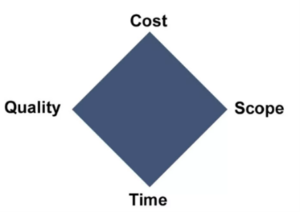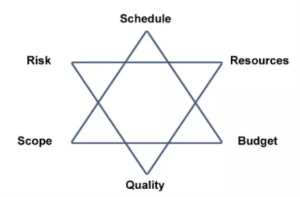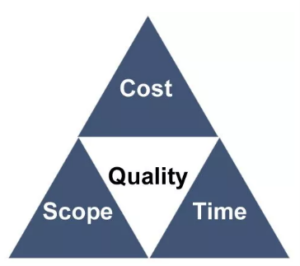New Year sale - up to 30% off training courses – use code: EARLYJAN26EUR
26 July 2019 | Updated on 20 June 2024
Project management triangle: overview of the triple constraints
Also known as the iron triangle or triple constraint, the project management triangle refers to three main constraints involved in any project. The delicate balance of these three elements can make or...

Also known as the iron triangle or triple constraint, the project management triangle refers to three main constraints involved in any project. The delicate balance of these three elements can make or break a project’s success.
What is the project management triangle?
The project management triangle is made up of three elements: cost, scope and time. It proposes that by effectively managing these three constraints the project team will be able to deliver a quality output.
What are the three components of the project management triangle?
The triple constraint referenced in the project management triangle is:
- Time: The schedule and deadline set out for the project
- Cost: The budget or financial resources allocated to the project
- Scope: The work that needs to be accomplished to deliver a successful project
Why use the project management triangle?
The project management triangle is a valuable tool for many reasons, it helps with:
- Balancing constraints: The triangle visually illustrates the link between time, cost and scope, helping project managers make informed decisions when changes occur to one or more of these elements
- Setting realistic expectations: When communicating with stakeholders, making use of the project management triangle can help to set realistic expectations by highlighting that a change in scope will likely lead to a change in budget or timeline, if not both
- Risk management: By taking the triple constraints into consideration, project managers can proactively identify the risk to these elements and develop contingency plans to mitigate their impact
- Decision-making: The triangle provides a structured framework for decision-making, and always keeps these core elements front of mind
- Performance measurement: Tracking a project against these three constraints allows project managers to compare actual progress to the planned targets for time, cost and scope
Why does the project management triangle use scope and quality interchangeably?
Scope and quality aren’t always the same thing. A simple project with a limited scope can still have extensive quality control. Some alternatives to the triple constraint do distinguish between scope and quality. Others put quality at the centre of a time/cost/scope triangle, as represented by this diagram.
The reason scope and quality are often used synonymously is that customers think in terms of deliverables. Deliverables are defined as ‘qualities/features that make the product fit for purpose’. To customers, the product is higher quality if it has more working features. So, if you think of scope as ‘what the project team can achieve’, it makes sense for quality to also fall under that definition.
Alternatives to the project management triangle
Project management diamond
 The project management diamond is essentially the triangle, but it lists scope and quality as two different factors. At the centre people will usually put either expectations or customer satisfaction.
The project management diamond is essentially the triangle, but it lists scope and quality as two different factors. At the centre people will usually put either expectations or customer satisfaction.
Project management star
 The PMBOK® Guide uses a popular alternative model to the triple constraint. It lists six constraints, made from two overlapping triangles in a star shape.
The PMBOK® Guide uses a popular alternative model to the triple constraint. It lists six constraints, made from two overlapping triangles in a star shape.
As you can see, the project management star also distinguishes between scope and quality. Here, it says scope is constrained by budget and schedule, while quality is assured by managing risks and resources.
How to determine and apply the triple constraint
Before starting a project, the three constraints detailed in the project management triangle must be discussed with your client. You need to confirm their exact budget, expected timelines, and scope requirements, as your ability to meet these objectives will ultimately determine the success of your project.
Struggling to manage the triple constraints? Our PRINCE2® training will provide a structured methodology for project management, helping you remain on track to reach client objectives in time, cost, and scope.
Learn more about our PRINCE2 courses.


